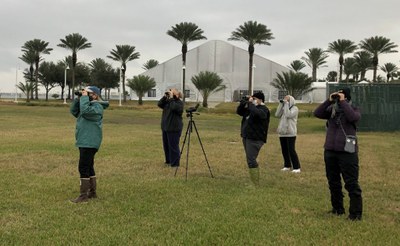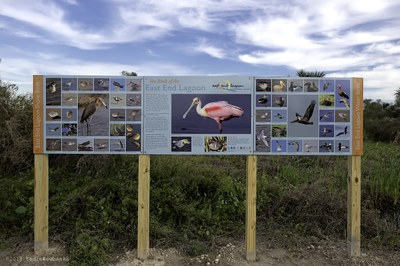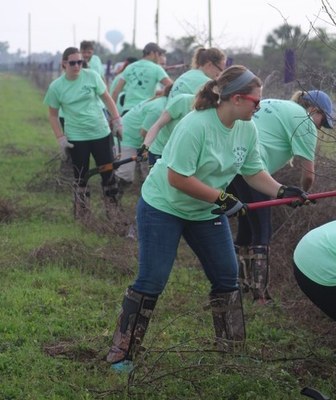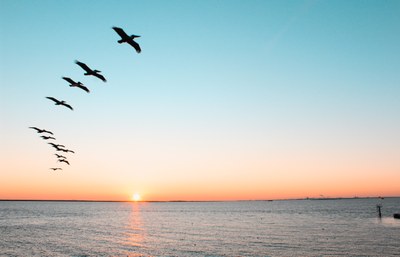Galveston: Bird City Texas Certified Community
Learn more about the excellent work being done in Galveston to involve their community, improve habitat, and create safer spaces for birds. Below you will find some details about Galveston as well as a few examples of the local bird-friendly initiatives they have implemented that led to their Bird City Texas official certification. This list is not exhaustive but hopefully helps give insight on what local communities are doing to support birds and the spaces where they live. We hope these examples help you discover ways your community can work to protect birds and their habitat where you live.
Details
| Population: | 52,000 |
|---|---|
| Acres of Parkland: | 34,600 |
| Dates of certification: | 2021-2023 |
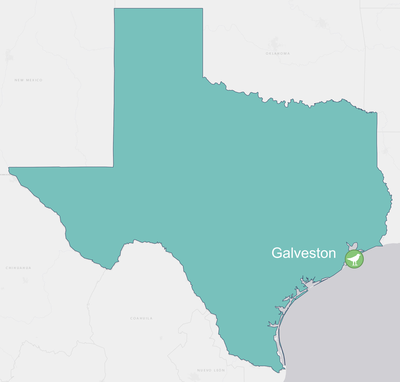
Community Engagement
Galveston values their people as much as their birds and it shows when you see how the community engagement is blending community science and action for better habitats. Galveston hosts multiple community science events each year, including an annual Big Sit at Moody Gardens and bio-blitzes with Artist Boat. They’re also making birding more comfortable and accessible by adding signage and benches at popular spots like the Seawall Interpretive Trail and continuing their annual FeatherFest with modifications for safety in the age of COVID.
Habitat Enhancement and Protection
Habitat management is a combination of invasive species removal, planting of native varieties essential for food and shelter of birds, as well as maintenance of thriving, helpful species, all of which Galveston does well at a variety of locations, including Galveston Island State Park, Lafitte’s Cove Nature Preserve, and Artist Boat’s Coastal Heritage Preserve. One of the methods deployed to keep invasive species in check and promote the natural regeneration of native grasses and forbs is called a prescribed burn, which is in active use at the Galveston Island State Park.
Creating Safer Places for Birds
Like many of the Bird City Texas communities, Galveston recognizes that one of the biggest threats to birds is light pollution during critical migration periods. Galveston is doing their part to encourage community members to turn off lights during the big migration pushes in Spring and Fall, and the community participates in the National Lights Out campaigns being developed by Cornell Lab of Ornithology.
Want to learn more?
Contact Galveston directly to learn more about what they are doing to protect birds in their community.
Additional Resources
Certification Criteria Commitment
Certified communities make a three-year commitment to accomplish specific projects, host bird-related events, promote local initiatives, pass bird-friendly ordinances, and more in order to achieve certification. These commitments fall into three categories: Community Engagement, Habitat Enhancement and Protection, and Creating Safe Spaces for Birds. Each category has a minimum requirement of actions a certified community must select. In addition to the example listed above, Galveston has also committed to complete the following actions for each of the three categories.
Category 1: Community Engagement Criteria (5 required)
- Participates in at least one community science program annually
- Engage in long-term local bird monitoring programs that incorporate eBird and/or iNaturalist
- Create bird watching amenities in public parks
- Public parks have signage that prioritizes bird ID and native bird ecology in their message
- Quarterly column/outreach/social media outreach centered on native birds
- Speaker/workshop series focusing on birds, wildlife, habitat, environmental stewardship. Minimum 3/year
- Annual bird festival that promotes community stewardship and appreciation of native birds and their habitats
Category 2: Habitat Enhancement and Protection Criteria (8 required)
- Acquire and conserve land for birds, wildlife, and native plant communities
- Modify and improve existing habitat for birds, wildlife, and native plant communities
- Create and conserve wildlife corridors and connectivity between habitat areas
- Adopt native-only recommended list for all new business and residential developments
- Use prescribed fire to benefit birds and native ecosystems
- Implement seasonal management practices that protect nesting birds
- Manage natural areas to encourage wildlife habitat, including “No Mow” areas for native plants
- Sponsor at least 5 habitat restoration projects of at least 1 acre in size in the community
- Conduct inventory of city lands to document plant and animal species and assesses habitat quality
Category 3: Creating Safer Spaces for Birds Criteria (4 required)
- Participate in National Lights Out Program
- Provide alternative transportation throughout the community (hike/bike trails, rideshares, bike lanes)
- Remove invasive or harmful animal species, including some bird species, deer, and/or wild pigs.
- Prohibits the formation, maintenance, or support of outdoor cat colonies inside or adjacent to parks/natural areas. Removal of cat colonies within or adjacent to parks/natural areas will qualify
- Monitor and limit the release of native wildlife and prohibit the release of domestic animals
